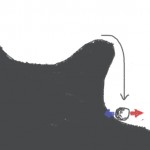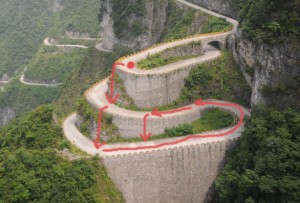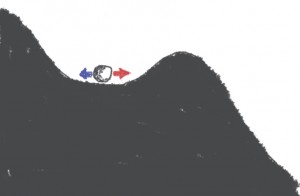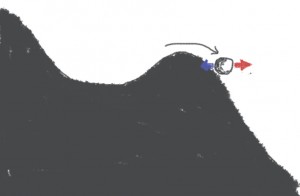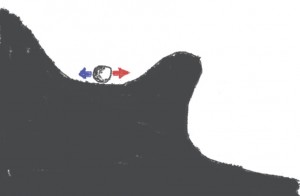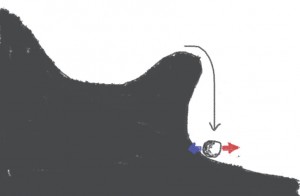Recently, Nikos Logothetis announced that he quit primate research because of lack of support against animal activism. Logethetis is a highly respected scientist; one of his contributions is the understanding of the relation between fMRI, a non-invasive brain imaging technique, and neural electrical activity, as recorded with electrodes. In other words, his work allows scientists to use non-invasive recording techniques in experiments instead of implanting electrodes into animal brains; in particular, it allows scientists to use humans instead of animals in some experiments. Quite paradoxically, animal activists chose him as a target in September 2014, when an animal rights activist infiltrated his lab to shoot a movie that was broadcasted on German television. The movie showed a rare emergency situation following surgery as if it were the typical situation in the lab, and it showed stress behaviors deliberately provoked by the activist (yes: the activist intentionally induced stress himself in the animal and then blamed the lab!).
This case raises at least three different types of questions: political, moral and epistemological. Here I mainly want to address the epistemological question, which is the role of animal experiments in knowledge, but let me first very briefly address the two other questions.
First, the political question: it's anybody's right to think that animals should not be used for research, but it's an entirely different thing to use manipulation, slander and terrorism rather than collective social debate for that end. There is ongoing debate about the conditions of animal experiments in research and there are strict regulations enforced by governmental bodies. As far as I know, Logothetis followed those regulations. Maybe regulations should be stricter (the moral question), but in any case I don't think it's right to let minority groups impose their own rules by fear.
Second, the moral question: is it right to use animals (either kill or inflict pain or suffering) for the good of our own species? As all moral questions (see Michael Sandel's excellent online lectures), this is a very difficult question and I'm not going to answer it here. But it's useful to put it in context. About 10 billion land animals (mostly chicken) are killed every year in the US for food. We are all aware that the living conditions of animals in industrial farms is not great, to say the least. According to official data, there are about 1 million warm-blooded animals used for research every year in the US (of which a fraction are killed), excluding mice and rats, which might account for about 10 times more. Animal use is much tightly regulated in research than in industrial farming (for example, any research project needs to be approved by an ethical committee). So animals used in research represent no more than 0.1% of all animals that are killed by humans. In other words, the effect of banning animal research would be equally obtained by having Americans eating 66.3 grams of chicken every day instead of their 67 gram daily consumption. This does not answer the general moral question, but it certainly puts the specific question of animal experimentation in perspective.
Finally, the epistemological question: what kind of science can we do without animal experiments? A number of animal rights activists seem to think that there are alternatives to animal experiments. On the other hand, many (if not most) scientists claim that virtually every major discovery, especially in medicine, has relied on animal experimentation. Since I'm a theoretical neuroscientist, I certainly think that a lot of science can be done without experiments. But it is definitely true that our civilization would be entirely different if we had not done animal experiments. And I'm not just talking about medicine or even biology. To give just one example, the invention of the electrical battery by Volta was triggered by experiments on frogs done by Galvani in the 18th century.
Probably the failure to recognize this fact comes a general misconception that the public has about the nature of research, the idea that discoveries come from specific projects aimed at making those discoveries, as if research projects were engineering projects. According to that misconception, there is medical or applied research, which is useful, and there is basic research, which does not seem to pursue any useful goal, apart from satisfying the curiosity of scientists. But the fact is: it is inaccurate to speak of “applied research”, the right terms should be applications of research. How can you invent a light bulb if you have never heard about electricity? Similarly, a lot of what we know about cancer comes from basic research on cells.
So it's clear that a large part of our knowledge and consequently our current welfare is linked to previous animal experimentation. Now there is a different question, which is: what can we do now without animal experimentation? First of all, there can be no new pharmaceutical drugs without animal experimentation. Any drug put on the market must pass a series of tests: first test the drug on an animal model, then test on humans for safety, then test on humans for efficacy. Most drugs do not pass those tests. If we ban animal tests, then we have to accept that an equivalent number of humans will face secondary effects or die. I don't think society will ever value animal life more than human life, so that means no more drugs would ever be tested.
This does not mean that all aspects of medicine rely on animal experimentation. For example, it would certainly be quite useful to develop prevention, and this could be done with epidemiological studies (although they are certainly quite limited), or with intervention studies in humans (e.g. experimenting with the diet of human volunteers). So prevention could progress without animal experimentation (although animal experiments would certainly help), but progress of cures, probably not. By pointing this out, I am not making a moral or political statement: you could well argue that, after all, better prevention might save more lives than better cures and so perhaps we should focus on the development of prevention anyway and get rid of animal experimentation. But one has to keep in mind that it means essentially giving up on curing diseases, including new infectious diseases (and those happen: in 1918, Spanish flu killed 50-100 million people).
How about basic research, which, as I pointed out above, is the basis of any kind of application? There is of course a lot of interesting research that does not rely on animal experimentation. But if you want to understand biology, you need at some point to look at and interact with biological organisms. What kind of alternative can there be to animal experiments in biology? First of all, let me make a very elementary observation: to demonstrate that something can be used as an alternative to animal experiments, you first need to compare that thing with animal experiments and so you need to do animal experiments at least initially. This is basically what Logothetis did when comparing fMRI signals with electrophysiological signals in monkeys.
I can think of only two possible alternatives: human experiments and computer models. Let's start with human experiments. I have read somewhere that we could use human stem cells for biological experiments. This may well apply to a number of studies in cellular biology. But a cell is not an organism (except for unicellular organisms), so you can't understand human biology by just studying stem cells. Human stem cells won't help you understand how the brain recovers after a stroke (or at least not without other types of experiments), or how epileptic seizures develop. You need at some point to use living organisms, and so to do experiments on living humans, not just human cells. But the kind of experiments you can do on living humans is rather limited. For example in neuroscience, which is my field, you cannot directly record the activity of single neurons, except during surgery on epileptic patients. These days a lot of human experiments are done using fMRI, which is an imaging technique that measures metabolic activity (basically oxygen in the blood vessels of the brain) at a gross spatial and temporal scale. Then to interact with a human brain, there are not many ways. Essentially, you can present something through normal sensory stimulation, for example images or sounds. The kind of information we get with that is: that brain area is involved in language. Useful maybe, but that won't tell us much about how we speak, and certainly not very much about Alzheimer and Parkinson diseases. A lot of modern biology uses mice with altered genomes to understand to the function of genes (e.g. you suppress a gene and see what difference it makes to the organism, or to the development of pathologies). Obviously this can't be done in humans. In fact, even if it were ethically right, it would not even be practical because human development is too long. So, in most cases, animal experiments cannot be replaced by human experiments. Again this is not a political or moral statement: it's anybody's right to think that animal experiments should be banned, but I'm simply pointing out that human experiments are not an alternative.
The other potential alternative is to use computer models instead of animals to do “virtual experiments”. As I am a computational neuroscientist, I can tell you with very high confidence that there is no way that a computer model might be useful for that purpose either now or in the foreseeable future. It is unfortunate that some scientists have occasionally claimed otherwise, perhaps exaggerating their claims to get large funding. We still have no idea how a genome is mapped to an organism. In fact, even when we have the complete sequence of a gene, and therefore the complete specification of the composition of the protein it encodes, we don't know how the protein will look like in a real cell, how it will fold - let alone the way it interacts with other constitutents of cell. And so we are far, very very far, from having something that remotely looks like a functional computer model of a cell, let alone of an organism. Today the only way to know the function of a gene is to express it in a living organism. The same is obviously true of the brain. No one has ever reported that a simulated neural network was conscious, so something quite important must be missing. We have some good (but still incomplete) knowledge of the electrophysiology of neurons, but little knowledge of how they wire, adapt and coordinate to produce behavior and mind. Computer models are not used to simulate actual organisms – not one computer model has ever been reported to live or think. They are used to support scientific theories, which are built through theoretical work combined with empirical (experimental) work (you can have a look at this series of posts on the epistemology of computational neuroscience, starting with this one).
So no, animal experiments cannot (for most of them) be replaced by human experiments or computer simulations. A lot of research can be done without animal experimentation, but it is a distinct type of research and it cannot answer the same questions. Of course, one can consider that those questions are not worth answering, but this is a moral and political debate, which I have just scratched in this post. But as far as epistemological questions are concerned, it is pretty clear that there cannot be much research in biology without animal experiments.
We may agree that research in biology is important enough (say, at least as important as 0.1% of the chicken we eat) and still care about the welfare of animals, try to reduce the number of animals used in research, and reduce their suffering. This is of course partly the job of ethical committees. Personally, I think one relatively simple way in which we could make animal experiments either less frequent or more useful is to impose that labs make all the experimental data they acquire publicly available, so that other scientists can use them (possibly after some embargo period). Today, for a number of reasons, the only data that come out from a lab are in the publications, generally in the form of plots, while tons of potentially useful data remain on hard drives, hidden from other scientists (see my previous post on this question). I think there is increasing recognition of that issue and potential, as seen in the emergence of data sharing infrastructures (e.g. CRCNS or the Allen Institute Brain Atlas) and in the new data sharing policies of some journals (e.g. Neuron or PLoS).

